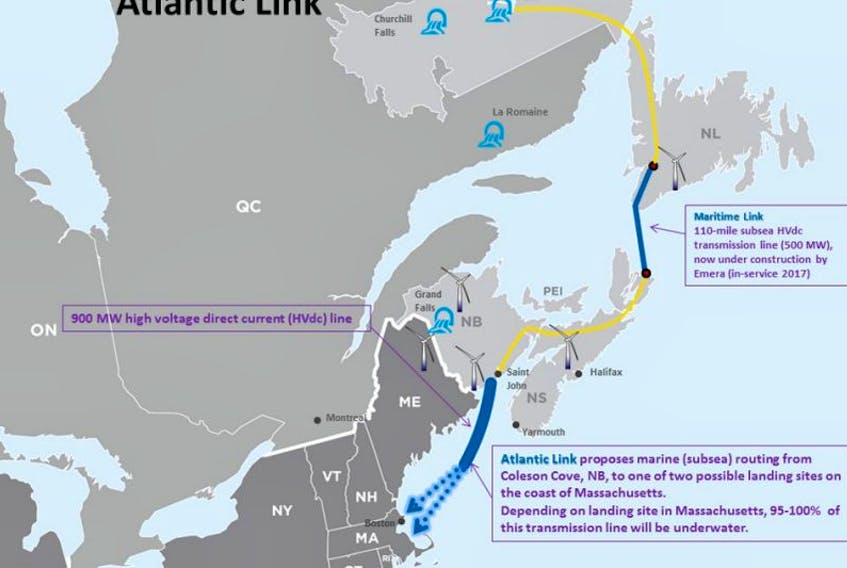The short answer appears to be: Emera gets a better deal from Muskrat Falls than Nalcor.
Probably a lot better.
“With all their hydroelectricity, Newfoundland doesn’t seem able to make good deals when it comes to finding buyers of the product,” said Larry Hughes, a Dalhousie University professor who studies energy issues, of the deals signed for both the Upper and Lower Churchill River developments.
The deal to get Muskrat Falls power to the mainland is often summed up as “20 for 20.”
That is, 20 per cent of the electricity generated at Muskrat Fall for 20 per cent of the capital investment.
But that’s an oversimplification and it’s also now incorrect.
“With all their hydroelectricity, Newfoundland doesn’t seem able to make good deals when it comes to finding buyers of the product.” — Larry Hughes, Dalhousie University professor
Because back in 2012, when the presidents of Nalcor and Emera Inc. along with the energy ministers of Newfoundland and Labrador and Nova Scotia sat down with their pens in a big room in St. John’s, they actually signed 13 deals totaling 1,500 pages of contract.
Those contracts laid out shares of costs and access to the two subsea links, across the Strait of Belle Isle and then the Cabot Strait, and from there on into New England.
But the basic premise remained — Emera gets 20 per cent of the power in return for building the then projected $1.4-billion Maritime Link between Cape Ray in Newfoundland and Point Aconi, Cape Breton. At the time that link was projected to cost 20 per cent of the estimated $5-billion Muskrat Falls project.
And for the first five years of after the turbines start turning, Emera will get a further 250 gigawatthours (GWH) of power to compensate them for Nalcor taking ownership of the Maritime Link after 35 years.
Emera would also get the right to buy 1,200 GWH of electricity at spot market prices in Massachusetts.
And the Halifax-based Emera would get to purchase up to 29 per cent of the Labrador Island link with a guaranteed rate of return for its investment.
But unless you live in a cave you’ve probably noticed that some things have changed since the ink dried in that St. John’s boardroom.
Read the entire series here
“We only need about one third of (the electricity) on the island (of Newfoundland)," Nalcor CEO Stan Marshall told The Canadian Press last November.
"So, what do we do with the other two thirds? To get it to market, we gave one third to Nova Scotia for 35 years, for nothing — other than it is in return for building the (Maritime Link). The remaining one third was supposed to be sold into the market at a big profit, but energy prices have collapsed in the northeast, and it will be sold for next to nothing.”
Muskrat Falls happened — building costs have skyrocketed to what is now an estimated $12.7 billion.
Natural gas happened — the spot power price for power in Massachusetts is about half what it was forecast to be in 2012.
Newfoundland needed money — Emera was able to purchase a 59 per cent investment in the Labrador-Island Link at a favourable rate of return (though Nalcor remains the owner).
By David Vardy’s calculations, if Emera chooses to buy all the electricity it has the right to, it will get 66 per cent of Muskrat Falls production.
While costs went up some on the Maritime Link, instead of 20 per cent, Emera’s total investment accounts for 11.8 per cent of the project’s capital costs.
Vardy, former chair of Newfoundland and Labrador’s Public Utility Board, thinks that the reality is so far off base from the original term sheet signed in 2010 between Emera and Nalcor that the province may have grounds to seek a change through the courts.
Sort of like the Churchill Falls (Labrador) Corporation attempted to do on Dec. 5 in its plea to the Supreme Court of Canada to force Hydro-Québec to renegotiate the 1969 deal that saw a massive hydro dam built farther up the river from Muskrat Falls.
While the Supreme Court will spend the next six months formulating its decision, the party from Newfoundland and Labrador got a rough grilling.
“When you enter into a 65-year contract, you must do that knowing the world will turn over a couple of times in the process," Justice Russell Brown said at one point.
Though Vardy has a long career in civil service and recently in policy research for Memorial University, one thing he’s not is a lawyer.
But he is an economist.
“It’s got to the point where this could put us under and lead to the bankruptcy of the province,” said Vardy, referring not just to the contracts with Emera but the entire Muskrat Falls situation.
“Our age structure is working against us, health-care costs are escalating and this Muskrat Falls is the perfect storm.”









